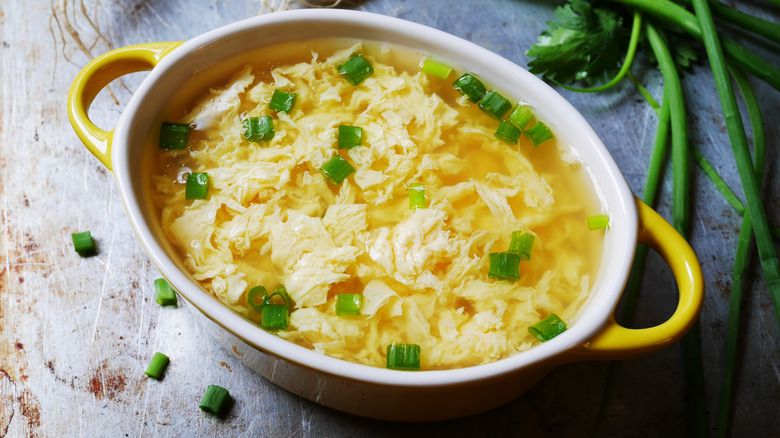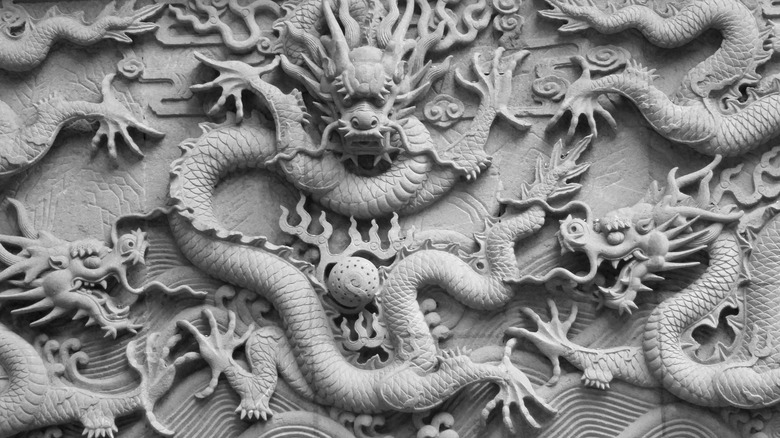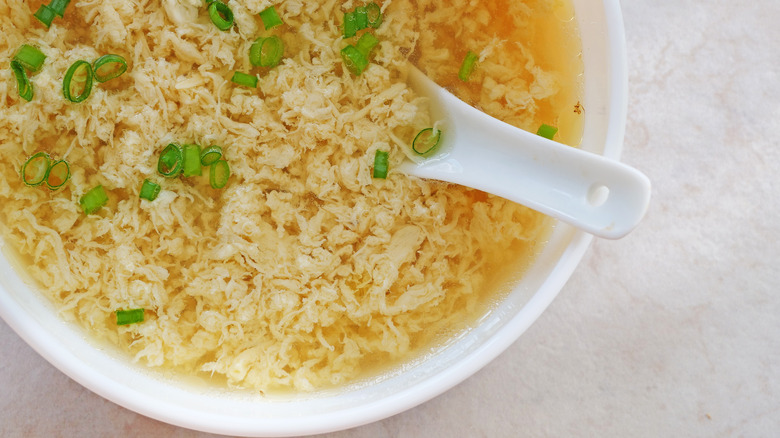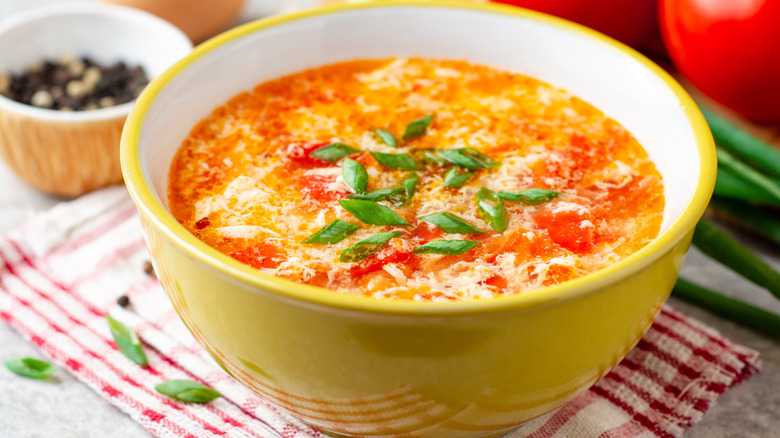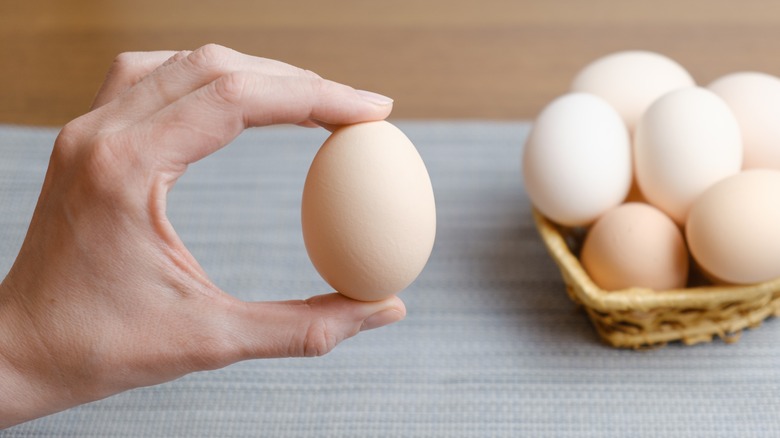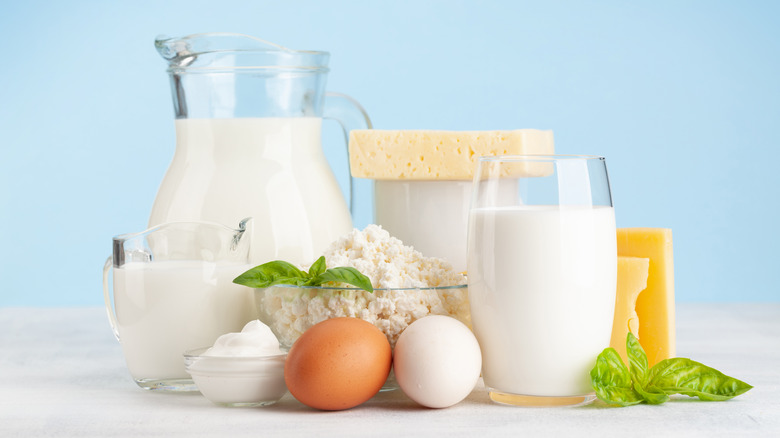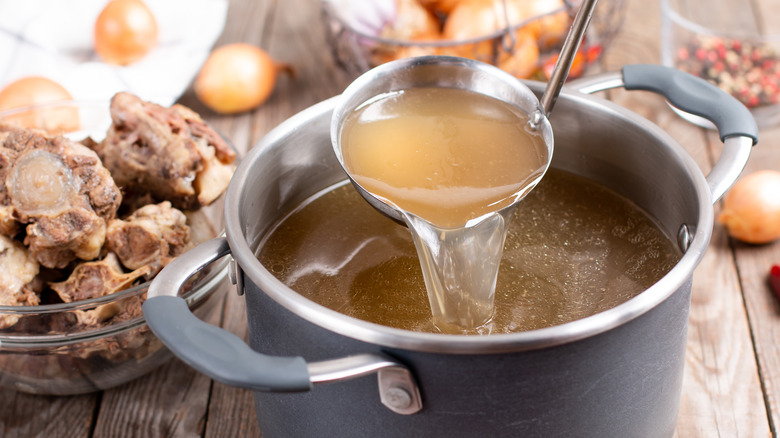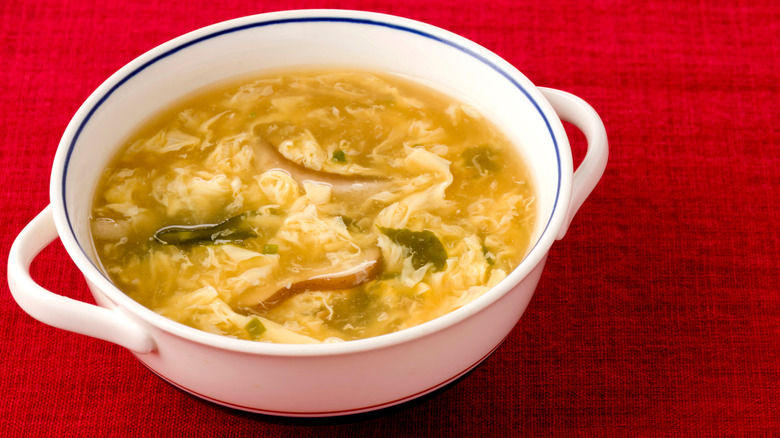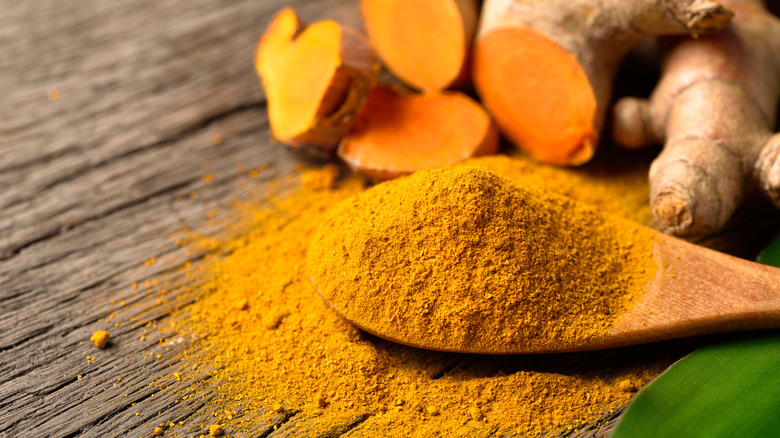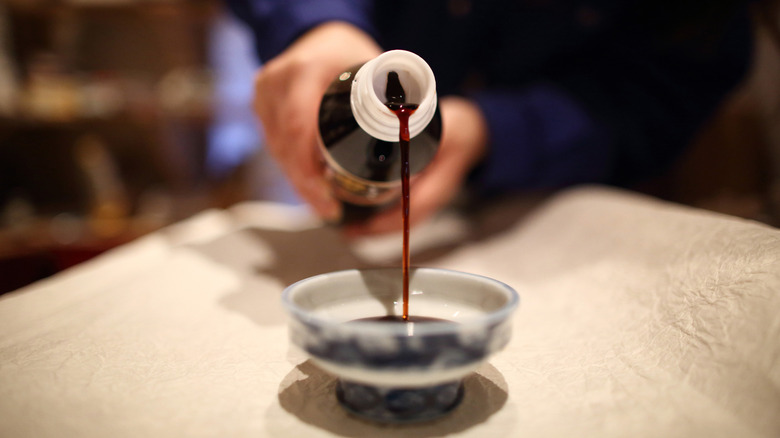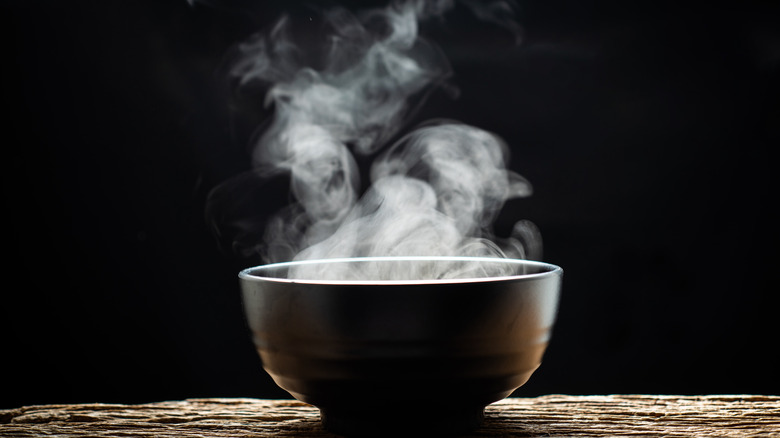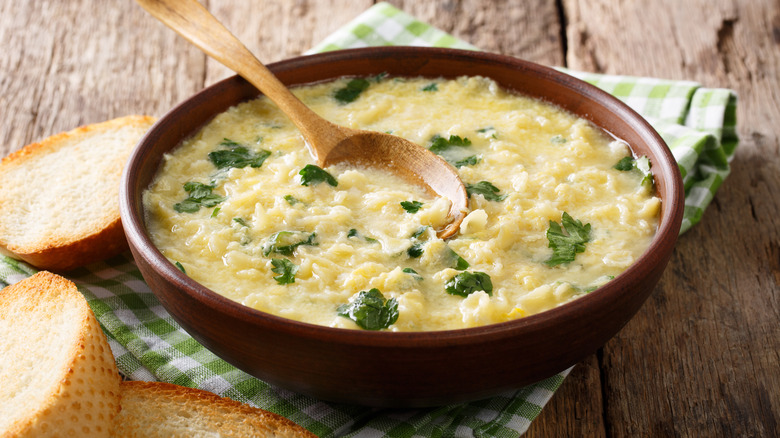The Untold Truth Of Egg Drop Soup
Egg Drop Soup can be commonly found on the menu of many Chinese restaurants in the United States. According to Taste Atlas, this soup is one of the most well-known and beloved Chinese soups both within and beyond the country. The base ingredients of this soup are fairly humble.
It consists of raw eggs that are whisked and then "dropped" into hot broth: You could stop there, or you could add other ingredients like cubes of firm tofu, chopped scallions, green peas, or tomato. The broth in this soup may be thickened or watery, it depends on the region as much as on personal taste.
It's simple, versatile, and loved by many. But what is it about this basic, yellow broth with its swirls of delicate egg whites that is so appealing? Why is egg drop soup sometimes also referred to as egg flower soup? Where did it come from? And how did it make its way all across the globe and become a staple dish on Asian restaurant menus in the U.S.? There's so much to know about this delicious and mysterious soup.
Egg drop soup is ancient
According to Smithsonian Magazine, chickens have been living alongside humans for several thousands of years. The red junglefowl (named Gallus gallus in Latin) lives in Southeast Asia and is the direct ancestor of the chicken. Chickens were initially bred for cockfighting. Eventually, people began to use chickens for their meat as well as their eggs: From there, it wasn't a big leap for people to start adding chicken and eggs to soup.
According to Bon Appétit, imperial Cantonese chefs used egg drop soup as a way to show off their culinary skills. Over time, different regions of China developed their own varieties of egg drop soup. For example, Hangzhou's West Lake Beef Soup is made beef, mushrooms, cilantro, and egg whites (via Asian Cooking Mom).
Cantonese chicken corn egg drop soup often contains sweet corn and finely chopped chicken (via Asian Cooking Mom). There is also a sweetened version of egg drop soup that is called Egg Tong Sui.
Is it called egg drop soup or egg flower soup?
Although this Chinese soup is commonly known as egg drop soup, it's sometimes also known by the name "egg flower soup." So, if "egg drop" is the more common name, then what is this "egg flower" business?
According to the Windchimes Chinese Restaurant in Dublin, Ohio, "egg flower" is actually the literal translation of the soup's Chinese name, dànhuātāng (in pinyin). As the culinary blog The Woks of Life explains, the "drop" refers to the way in which the egg is "dropped" into the broth. The "flower" describes the way in which wisps of egg white in the soup appear petal-like as they float suspended in the glistening broth.
The speed of the stirring technique determines the size of the "flowers" in this soup. So, whether you order egg drop soup or egg flower soup, you will receive the same dish. One simply has a more poetic name than the other.
It was popular during the Great Depression
The Great Depression of the early 20th century was one of the most trying times in U.S. history (via History). 15 million people were unemployed, and many families struggled to maintain their former lifestyles. People found ways to make economical meals, and, according to Self-Sufficient Projects, egg drop soup became a highly popular dish across the country at the time.
The version that was consumed during the Great Depression wasn't precisely like the Chinese soup we know today, but it was pretty close. Clara Cannucciari of the Great Depression Cooking channel on YouTube recalls her mother browning chopped potatoes and onions with salt and pepper to form the base of the broth.
Water was added to the cooked potatoes and onions, and after sufficient time boiling on the stove top, raw eggs were stirred into the hot soup. To complete the delicious and nutritious meal, Cannucciari serves this soup ladled over a toasted slice of bread
There are multiple recipes of egg drop soup
You may have already gathered that there is no single recipe for egg drop soup. As pointed out by The Irish Times, the base is made of broth and eggs but countless different ingredients can be added to this base to make exciting versions of this soup. The consistency of this soup can be controlled by the addition of a thickening agent such as cornstarch.
This simple soup is easily dressed up by the addition of crab meat, meatballs, cubed tofu, mushrooms, sweet corn, or greens like spinach. The Irish Times suggests transforming it into a "warming" broth with the addition of star anise or ginger, which, per Chef's Pencil, "have a warming effect on the body."
Tomato Egg Drop Soup, which The Woks Of Life declares a Chinese summer staple, can be served at room temperature if you'd rather not sip hot soup when the temperature is high. Tomatoes are packed with vitamins and nutrients, making them a terrific addition to any meal (via WebMD).
It's actually quite healthy
Egg drop soup is quite healthy, even without the addition of tomatoes or other vegetables. According to Livestrong.com, egg drop soup is low in both calories and carbohydrates. Chicken broth often forms the base of the soup and it is a good source of vitamins, minerals, protein, and essential fatty acids (per WebMD). Eggs are rich in nutrients; additionally, according to WebMD, each egg contains about 6 grams of protein. Eggs also increase "good" cholesterol (high-density lipoprotein) in the body and decrease "bad" cholesterol (low-density lipoprotein) (via Healthline).
You do need to keep an eye on the sodium level, though. SFGate suggests splitting an order of egg group soup with a dining companion or balancing out the sodium with an entree that is lower in sodium. If you make this soup at home from scratch, then you are in control of the salt content and can make a more informed decision about your meal. Adding vegetables and greens adds further nutrition to this soup.
Lacto-ovo vegetarians can eat egg drop soup
An ovo-vegetarian is a person who follows a vegetarian diet but also eats eggs. A lacto-ovo vegetarian is the same, except they also include dairy products in their diet. So, by definition, egg drop soup can be eaten by people following these diets.
But wait! What about the broth? According to Your Vegan Journey, all you need to make egg drop soup suitable for an ovo-vegetarian diet is vegetable broth. The common additions of salt, pepper, tofu, scallions, and cornstarch (used to thicken the broth) are all not only vegetarian but vegan friendly. If you're ordering soup from a restaurant, it's a good idea to check if the broth is vegetable- or meat-based.
With a little effort, you can also make vegan-friendly egg drop soup by substituting the eggs with something like the plant-based JUST Egg, which is made from mung beans and turmeric (via Foods Guy). Vegan recipes of this soup can also incorporate silken tofu.
The type of broth used can drastically affect the flavor
According to Taste Atlas, chicken broth is the most commonly used broth in egg drop soup, however, vegetable broth can also be used. Clear broth generally does not contain any pieces of food (via Livestrong). It forms the basis of many Asian soups, including egg drop soup (via The Woks of Life)
Any combination of meat, bones, and vegetables can be used in this soup. Simply throw these ingredients in water and let them simmer. A Reddit user points out that vegetable broth often is weaker in flavor than meat or bone broths, but adding ingredients like mushrooms and leeks will offer a bolder taste.
In addition to these ingredients, additives like herbs, spices, or even vinegar will affect the flavor of the broth also (via Bluebird Provisions). The combinations are infinite, so egg drop coup can easily be made to personal taste. For this reason, although most Chinese restaurants offer this soup, the flavor of each dish varies in terms of taste.
The broth should be thick
The signature of egg drop soup is the way in which the egg swirls through the soup in white ribbons like flower petals or clouds. There are two things that are crucial to achieving the trademark of this soup: A very careful pour and the consistency of the broth (via Devour Asia).
The broth needs at least a little bit of thickness to properly suspend the eggs. One easy way of achieving this is by adding a form of starch such as cornstarch or tapioca starch. Since the broth needs to be thick enough to hold eggs, it must be added before pouring in the eggs. And, in order to avoid clumps of starch, it's important to completely dissolve it in a little bit of liquid before adding it to the soup.
A Seasoned Advice user also points out that a quality broth will also help as it should naturally include some density even without added thickeners. The more concentrated the broth is, the better it will suspend the eggs.
It's not really that yellow
If you've ever ordered egg drop soup in a restaurant, then you are familiar with the almost aggressively yellow color (via Reddit). This color is likely derived using a concentrated chicken soup base, and achieving the same color when making your own soup at home can be difficult.
Of course, the bright, golden yellow that we typically associate with egg drop soup can be, and often is, achieved with the help of food dyes (via Fix). Commercial yellow food dyes are one option, but you can also use natural dyes like golden beets, turmeric, and saffron.
Carrot juice offers a more orange-colored hue. You'll want to use caution when adding turmeric because its flavor is on the bitter side (via The Fitness Manual). Saffron also adds its own flavor: Just a few threads of saffron will add a sweet and savory flavor to the soup (via Raw Spice Bar).
It might not be gluten free
Egg drop soup has eggs, broth, and other add-ins (via Taste Atlas). Egg drop soup does not contain bread or grains, so where is the gluten coming from? Believe it or not, it could be hiding in the broth. As certified holistic health coach Rachael Roehmholdt points out, soy sauce is often added to flavor egg drop soup.
Soy sauce traditionally includes gluten. Soy is gluten-free, but wheat is a key ingredient in the making of soy sauce (via Beyond Celiac). Gluten-free soy sauces are available, such as the Japanese dark soy sauce tamari, which is a byproduct of miso production. However, when ordering from a restaurant, you will need to verify with the server whether or not the soup uses conventional soy sauce or not.
Coconut aminos is another gluten-free alternative to soy sauce (via Healthline). It's also beneficial for people looking to reduce sodium or eliminate soy from their diets. It's sweeter than soy sauce, but the overall taste is still savory.
Yes, the eggs are cooked
Consuming raw eggs is a risky business. For starters, they may contain salmonella bacteria, which can make you sick. Young children, older adults, and people with weakened immune systems are particularly at a high risk of becoming seriously ill from salmonella. You should always ensure the eggs you eat are properly refrigerated and fully cooked. A temperature of 160 degrees Fahrenheit or higher will kill the bacteria.
Luckily, the broth in egg drop soup is hot enough to cook eggs since the boiling point of water is 212 degrees Fahrenheit. One way to make sure that the eggs in your soup are cooked thoroughly is to verify the ribbons of white are floating rather than sinking to the bottom of the bowl (via Parental Questions). If you have access to a microwave, you can heat up the soup to ensure that the eggs reach a high enough temperature to eliminate any bacteria.
Italian cuisine has a similar soup
Stracciatella alla romana literally translates as "little rags in the Roman style" (via Taste Atlas and WordSense). But it's often simply referred to as Italian egg drop soup. While the makers of Chinese egg drop soup think that the swirls of egg whites resemble flower petals, thus naming it egg flower soup, Italians feel that they resemble little white rags.
While "little rags" is not quite as pretty as "egg flower soup," this Italian soup is beloved by many. Daniela Savone shared on La Cucina Italiana that when she was sick as a child, her grandmother would make this soup for her. She still reaches for stracciatella today when she is feeling under the weather and is seeking comfort.
The main difference between this Italian egg drop soup and the Chinese egg drop soup is that the Italian version calls for grated Parmigiano Reggiano cheese to be mixed in with the eggs before being poured into the hot broth. Otherwise, the base ingredients are the same, and a similar whisking technique is used when pouring the eggs.
